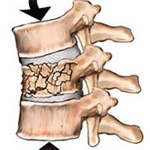Spinal fractures occur when the normal vertebral body is “squashed”, or compressed in height. Spinal compression fractures may also be called Spondylolysis. When the load on a vertebra exceeds its stability or inherent strength, the bone can collapse. Pain, limited mobility, height loss and spinal deformity are often the result. In severe cases, part of the vertebral body may protrude into the spinal canal and put pressure on the spinal cord and nerves. Organ function, including that of the bowel or bladder, also may be compromised.
They may occur anywhere in the spine, but are most often found in the lower vertebrae of the upper back. The vertebral bone tends to collapse toward the front of the spine, creating wedge-shaped vertebrae that cause the spine to curve forward (kyphosis), eventually leading to the “dowager’s hump” frequently associated with the advanced stage of the disease.


